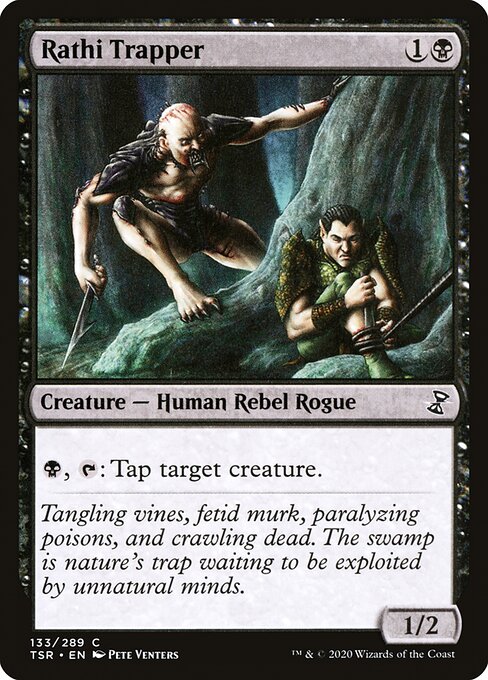
Image courtesy of Scryfall.com
Rarity, Perception, and a Subtle Rogue from Time Spiral Remastered
Magic: The Gathering has long traded not just in mana and strategy, but in perception. The psychology of rarity shapes our choices long before a game begins. We remember the big splashy mythics, chase the chase-worthy foils, and sometimes overlook a quiet workhorse that sits at the threshold of ordinary and essential. Enter Rathi Trapper, a humble common from Time Spiral Remastered, a card that teaches a compact lesson: power isn’t always loud, and scarcity isn’t the only shorthand for value. 🧙♂️🔥
Rathi Trapper is a blue-collar predator with a black belt in tempo. For {1}{B} mana, you get a 1/2 Human Rebel Rogue who asks you to tap your own mana for tactical disruption: {B}, {T}: Tap target creature. It’s not flashy—indeed, it’s the kind of card your cube sideboard whispers about when you’re building a lean, mean black deck. Yet its utility compounds as the game unfolds: a single activation can swing an early exchange, whittle away an opponent’s board presence, and help you set up a favorable midgame transition. The flavor text—“Tangling vines, fetid murk, paralyzing poisons, and crawling dead. The swamp is nature's trap waiting to be exploited by unnatural minds.”—reads as a wink to the archetype: even the land’s most unassuming residents can outthink a rival’s plan. ⚔️
From a psychology standpoint, players often equate rarity with superiority. A common card like Rathi Trapper fights that bias in two ways. First, it demonstrates that an efficient, well-timed play can outperform gaudy individual power; second, it highlights the social signaling around card rarity. When you pull a rare or mythic, your brain cues reward pathways with a hit of dopamine; when you see a common, you might discount its impact, even if the board state says otherwise. The trap is subtle: you might undervalue the “little things” that compound into a win. A well-timed exile of a single blocker here, a quiet tempo shift there—suddenly the match feels winnable because you didn’t wait for a big spell to answer a small threat. 🧲
“Rarity isn’t a verdict on a card’s usefulness; it’s a snapshot of supply, demand, and memory. The clever plays don’t always scream for attention.”
Time Spiral Remastered—the Masters set that reprints classics—offers a fascinating stage for this dynamic. Rathi Trapper’s common status in TSR reminds players that the set’s design philosophy often leaned toward reanimating familiar strategic motifs rather than forcing you to chase four-color mythic bombs. The card’s mana cost and color identity—{B}—anchor it in black’s archetypal toolkit: disruption, resource denial, and calculated aggression. Its printed rarity affects your expectations, but its on-table impact can punch above its weight when used with patience and timing. In other words, the rarest card in your hand doesn’t always win the race; the right common can, if you let it do the work. 🎨
From a deck-building perspective, Rathi Trapper invites a few interesting lines. In aggressive or midrange black builds, it serves as a low-cost deterrent that can stall an opposing plan just long enough to deploy larger plans. In controlled or blink-heavy shells, the ability to tap a creature taps into a classic tempo play—slowing an opponent enough to secure card advantage in the following turns. The interplay between such a creature and board-state evaluation is where psychology shines: players are more likely to commit resources to remove a perceived threat when they fear losing tempo, even if that threat is a modest 1/2 with a disruptive tap. The takeaway is simple—an active mind plus a simple tool can beat a flashy hand if you read the room correctly. 🧙♂️
Collectors and players alike often debate price and value. Rarity can influence perceived collectibility—foil versions may push the cost higher, while the base common remains delightfully affordable. The card’s long-tail value isn’t just about financial metrics; it’s also about the story you tell with a deck built around clever use of scarce resources. In a world where the latest expansion drops with fanfare, a well-placed common can become the (quiet) hero of many a victory. And yes, the occasional foil in your collection still feels nice when light hits the illustration by Pete Venters—the art that captures the swampy cunning of the Trapper. 🪄
As fans, we’re conditioned to chase the next big thing. But the psychology of rarity teaches us to look for the real upside: repeatable value, tactical nuance, and the satisfaction of turning a modest card into a tempo engine. Rathi Trapper embodies that paradox—a reminder that in MTG, the true thrill often hides in the fine print, not the headlines. ⚡
More from our network
- https://articles.zero-static.xyz/blog/post/best-early-game-weapons-guide-for-fire-emblem-engage/
- https://blog.digital-vault.xyz/blog/post/sphere-of-purity-exploring-its-legacy-in-mtg-fandom/
- https://blog.digital-vault.xyz/blog/post/lessons-from-silver-border-rule-bending-with-syphon-fuel/
- https://articles.digital-vault.xyz/blog/post/age-of-empires-iv-full-review-strategy-balance-and-tactics/
- https://blog.digital-vault.xyz/blog/post/telimtors-edict-bold-black-design-that-paid-off/